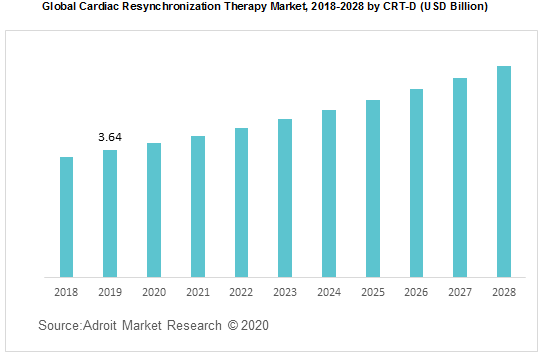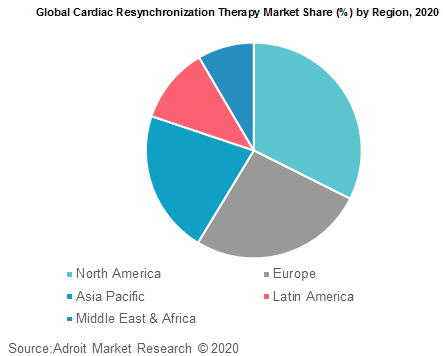The value of the Cardiac Resynchronization Therapy market is projected to grow to USD 10.9 billion with an estimated CAGR of 7.3 % by 2030
.jpg
)
The global cardiac resynchronization therapy market was valued at USD 5.68 billion in 2019 and is expected to grow at a CAGR of 7.6% over the forecast period. Rising incidence of heart failure & other cardiac rhythm management devices medical conditions, continuous investment in R&D by major players, coupled with increasing sedentary lifestyle in the population is anticipated to fuel injection the market growth.
Agencies such as the European Cardiology Society and the European Heart Rhythm Association have been formulating recommendations to increase awareness and encourage innovations in this area. These recommendations have been classified into three sub-sets that enable effective decision-making based on the type of patient.
Key players serving the global market include LivaNova, BIOTRONIK Boston Scientific, St. Jude Medical, among other prominent players.
Cardiac Resynchronization Therapy Market Scope
| Metrics | Details |
| Base Year | 2023 |
| Historic Data | 2018-2022 |
| Forecast Period | 2024-2030 |
| Study Period | 2018-2030 |
| Forecast Unit | Value (USD) |
| Revenue forecast in 2030 | USD 10.9 billion |
| Growth Rate | CAGR of 7.3% during 2020-2030 |
| Segment Covered | Product, End-user, Regions |
| Regions Covered | North America, Europe, Asia Pacific, South America, Middle East and Africa |
| Key Players Profiled | CRT-D and CRT-P. Key players serving the global market include LivaNova, BIOTRONIK Boston Scientific, St. Jude Medical, among other |
Key Segment Of The Cardiac Resynchronization Therapy Market
Product, (USD Billion)
• CRT-Defibrillator
• CRT-Pacemaker
End-user, (USD Billion)
• Hospital
• Cardiac Center
• Others
Regional Overview, (USD Billion)
North America
• US
• Canada
Europe
• Germany
• France
• UK
• Rest of Europe
Asia Pacific
• China
• India
• Japan
• Rest of Asia Pacific
South America
• Mexico
• Brazil
• Rest of South America
Middle East and South Africa
Frequently Asked Questions (FAQ) :
As of 2016, first, and second-generation products of the CRT industry are available in terms of technical advances. In addition, a third-generation model is ongoing, and Medtronic became a leader in 2016 by securing FDA clearance for two MRI-Safe CRT-D products. The products of the third generation are intended to promote MRI testing of patients implanted with these instruments without risk of incurring any complications or fatality.
Medtronic Plc., one of the major companies, makes tremendous investment for their cardiovascular business divisions to keep up-to - date with technological developments to satisfy patient needs. It announced a USD 1.64 billion investment in R&D activities as of 2015.
The growing number of geriatric patients across the globe is an ancillary factor promoting the development of this field. They are more vulnerable to disease, and are required to require these items of resynchronization therapy to promote healthier heart function. In reference to heart failure, such conditions such as irregular heartbeats, congenital heart disease, and vascular disease also require the use of certain instruments.
The global cardiac resynchronization therapy market has been bifurcated based on product and region. In terms of product the market is divided into CRT-D and CRT-P. Due to their higher level of scheduling operation and the capacity to record unfavourable events on time, CRT-D is predicted to lead as of 2019, thus reducing the mortality rate. Key players however are moving for further development. LivaNova, for example, launched a new generation of their CRT products underneath the brand name PLATINUM during 2015. These goods are supposed to offer an improved lifespan of over 10 years, according to the company.

Based on regions, the global cardiac resynchronization therapy market is segmented into North America, Europe, Asia Pacific, Central and South America and Middle East & Africa. Emerging markets such as APAC are giving companies major growth prospects in the demand for the Industry’s in coming years.
North America holds the largest share of market sales due to expanded awareness of the availability of high-quality laboratory knowledge research services and a favorable regulatory scenario that enhances regional demand growth. Furthermore, increasing number of approvals by U.S. FDA regarding new products is likely to favour the regional growth.
Europe also holds a large share and is expected to see more than 7 per cent robust growth with CAGR in the next 10 years. High stringency towards R&D, follow-up of the protection standards and product approvals are required to accelerate development by the healthcare agencies.


